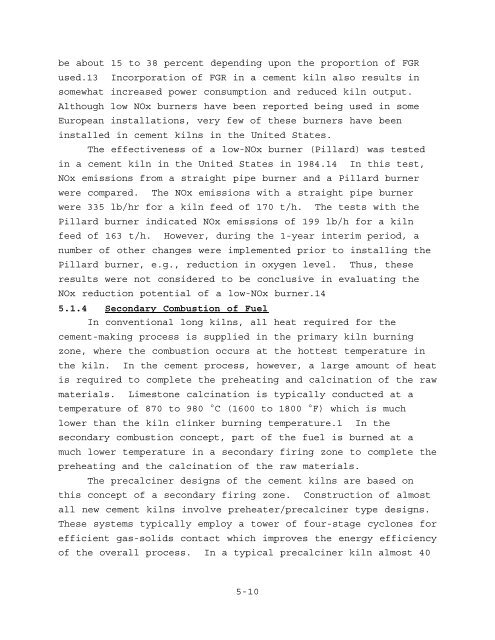NOx Emissions from Cement Mfg - US Environmental Protection ...
NOx Emissions from Cement Mfg - US Environmental Protection ...
NOx Emissions from Cement Mfg - US Environmental Protection ...
You also want an ePaper? Increase the reach of your titles
YUMPU automatically turns print PDFs into web optimized ePapers that Google loves.
e about 15 to 38 percent depending upon the proportion of FGR<br />
used.13 Incorporation of FGR in a cement kiln also results in<br />
somewhat increased power consumption and reduced kiln output.<br />
Although low <strong>NOx</strong> burners have been reported being used in some<br />
European installations, very few of these burners have been<br />
installed in cement kilns in the United States.<br />
The effectiveness of a low-<strong>NOx</strong> burner (Pillard) was tested<br />
in a cement kiln in the United States in 1984.14 In this test,<br />
<strong>NOx</strong> emissions <strong>from</strong> a straight pipe burner and a Pillard burner<br />
were compared. The <strong>NOx</strong> emissions with a straight pipe burner<br />
were 335 lb/hr for a kiln feed of 170 t/h. The tests with the<br />
Pillard burner indicated <strong>NOx</strong> emissions of 199 lb/h for a kiln<br />
feed of 163 t/h. However, during the 1-year interim period, a<br />
number of other changes were implemented prior to installing the<br />
Pillard burner, e.g., reduction in oxygen level. Thus, these<br />
results were not considered to be conclusive in evaluating the<br />
<strong>NOx</strong> reduction potential of a low-<strong>NOx</strong> burner.14<br />
5.1.4 Secondary Combustion of Fuel<br />
In conventional long kilns, all heat required for the<br />
cement-making process is supplied in the primary kiln burning<br />
zone, where the combustion occurs at the hottest temperature in<br />
the kiln. In the cement process, however, a large amount of heat<br />
is required to complete the preheating and calcination of the raw<br />
materials. Limestone calcination is typically conducted at a<br />
temperature of 870 to 980 EC (1600 to 1800 EF) which is much<br />
lower than the kiln clinker burning temperature.1 In the<br />
secondary combustion concept, part of the fuel is burned at a<br />
much lower temperature in a secondary firing zone to complete the<br />
preheating and the calcination of the raw materials.<br />
The precalciner designs of the cement kilns are based on<br />
this concept of a secondary firing zone. Construction of almost<br />
all new cement kilns involve preheater/precalciner type designs.<br />
These systems typically employ a tower of four-stage cyclones for<br />
efficient gas-solids contact which improves the energy efficiency<br />
of the overall process. In a typical precalciner kiln almost 40<br />
5-10

















